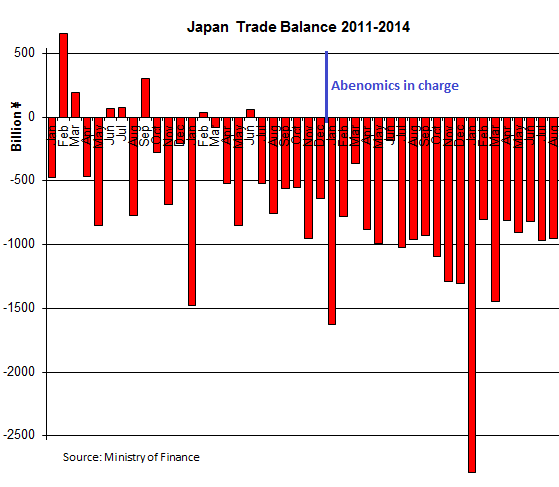 One of the most important goals of Japan’s newfangled, democratically elected economic religion is to stimulate the economy for Japan Inc., if for no one else, by boosting exports (by making them cheaper overseas) and curtailing imports (by making them too expensive in Japan). To get there, Prime Minister Shinzo Abe and the Bank of Japan have agreed to water down the yen, and thus the wealth and earnings power of the Japanese.
One of the most important goals of Japan’s newfangled, democratically elected economic religion is to stimulate the economy for Japan Inc., if for no one else, by boosting exports (by making them cheaper overseas) and curtailing imports (by making them too expensive in Japan). To get there, Prime Minister Shinzo Abe and the Bank of Japan have agreed to water down the yen, and thus the wealth and earnings power of the Japanese.
To execute that noble strategy, the BOJ went on a money printing binge. It worked: the yen has dropped over 30% to the dollar since the election campaign in late 2012. It accomplished all sorts of goals: the yen-denominated wealth of the Japanese was cut by over 30%, real wages were cut as well, the economy is in shambles….
The one thing it hasn’t accomplished is the original goal of increasing exports and lowering imports, thus creating that all-important trade surplus that would goose GDP and make Abe and the Bank of Japan smell like a rose. The Ministry of Finance sprinkled salt on the wound today with the trade statistics for August.
Exports, instead of soaring due to the watered-down yen, dropped 1.3% from a year ago to 5.7 trillion. Imports edged down 1.5% to 6.7 trillion, mostly due to petroleum imports, the largest category, which fell by 5.2% based on the lower price of oil on the world markets. This alone contributed 0.9 percentage points to the 1.5% drop in imports. The other factor: consumers, squeezed by higher prices and declining real incomes, have been curtailing consumption. As a result, the goods trade deficit inched down 2.4% to 948 billion…
This post was published at Wolf Street on September 18, 2014.

 Follow on Twitter
Follow on Twitter
Recent Comments